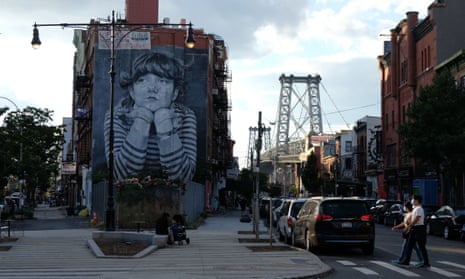The New York governor, Andrew Cuomo, has agreed to close schools from Tuesday in several New York City neighborhoods, due to a resurgence of the coronavirus.
The crackdown, requested by the New York mayor, Bill de Blasio, is warranted due to high rates of infections in several hotspots, Cuomo said on Monday. While the positive infection rate for the state is relatively low at 1%, outlying zip codes have rates as high as 5.5% due to mass gatherings and violations by religious institutions, according to the governor.
“I wouldn’t allow a school to open that I wouldn’t send my child to, that’s my test,” Cuomo said, acknowledging that many New Yorkers will be unhappy with the shutdowns.
“Enforcement is kind because enforcement saves lives. I’d rather you be alive and angry with me.”
The move, effective from Tuesday morning in nine zip codes in Brooklyn and Queens, is a disheartening retreat for a city that enjoyed a summer with less spread of the virus than most other parts of the US, and recently celebrated the return of students citywide to limited in-person learning in classrooms.
De Blasio had requested for non-essential businesses in those zip codes also to close, but the governor has yet to approve the measure and said for now only schools would be closing. If it is approved, the mayor said non-essential businesses in the hotspot areas would close on Wednesday morning.
On Monday De Blasio urged people in those areas to limit their activity, stay at home when possible, wear masks, practice social distancing and avoid gatherings.
An additional 12 zip codes are on a “watch list”, he said, and would not be subjected to the greatest restrictions “unless and until” they have seven consecutive days above 3% positivity. But he urged people living in those areas to get tested.
“We’re proposing a very tough plan of action right now to address this situation and to ensure that it does not turn into a second wave all across New York City,” De Blasio said on Monday. “We still have time to avert that problem and that’s what I want us all to focus on, stopping this problem right now.”
Shutdowns would happen starting on Wednesday in nine zip codes in the city, De Blasio said on Sunday.
Cuomo, who has a strained relationship with De Blasio, criticized violations of mask-wearing and social distancing rules and said the state will now oversee enforcement of the edicts.
“We have to be more aggressive,” Cuomo said. “I understand it’s impolitic, but we will see more people die if there’s not enforcement.”
He said the state will oversee enforcement in hotspot clusters.
About 100 public schools and 200 private schools will have to close. Indoor dining, which just resumed, will be suspended. Outdoor restaurant dining will shut down in the affected neighborhoods as well, and gyms will close. Houses of worship will be allowed to remain open with existing restrictions in place, De Blasio said on Sunday.
He said he was taking the action in an attempt to stop the virus from spreading deeper into the city and becoming a “second wave”, like the one that killed more than 24,000 New Yorkers in the spring.
“We’ve learned over and over from this disease that it is important to act aggressively, and when the data tells us it’s time for even the toughest and most rigorous actions we follow the data, we follow the science,” De Blasio said.
Over the past two weeks, new cases of the virus have been rising in pockets of the city, predominantly in neighborhoods in Brooklyn and Queens that are home to the city’s large Orthodox Jewish population. Nearly 1,100 people have tested positive in Brooklyn in just the last four days, according to state figures.
De Blasio made the announcement shortly after Cuomo complained that local governments with coronavirus hotspots had “not done an effective job” of enforcing social distancing rules.
“If a local jurisdiction cannot or will not perform effective enforcement of violating entities, notify the state and we will close all business activity in the hotspots where the local governments cannot do compliance,” Cuomo said.
As many as 500,000 people live in the neighborhoods affected by the proposed shutdown, De Blasio said. He said the lockdown could be lifted in 14 days or 28 days if the percentage of people testing positive for Covid-19 declines.
Around 7.5m cases of the coronavirus have been recorded in the US and around 210,000 people have died. The virus is estimated to have hit between 1 and 2 million people in New York City, mostly in the spring before testing was widely available. Thousands fell ill each day. By summer’s end, the city appeared to have the virus partly in check, averaging fewer than 240 new cases a day citywide as recently as 7 September.
Overall, the city’s infection rate remains relatively low, with about 420 new cases a day over the past few days, but those have been concentrated in a handful of neighborhoods. The nine zip codes singled out by the mayor have been responsible for more than 20% of all new infections in the city over the past four weeks, though they represent only 7% of the population.
